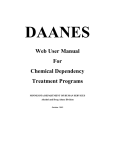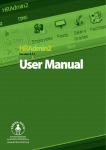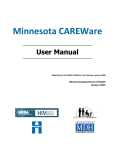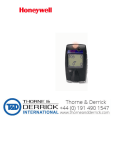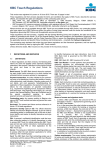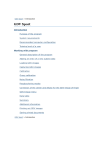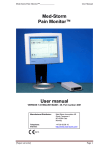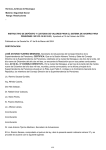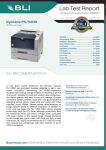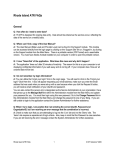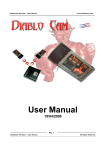Download DAANES Lite Manual - Minnesota Department of Human Services
Transcript
DAANES Web User Manual For Chemical Dependency Treatment Programs MINNESOTA DEPARTMENT OF HUMAN SERVICES PERFORMANCE MEASUREMENT & QUALITY IMPROVEMENT February 2013 DAANES Contact Information Web Address: https://DAANES.DHS.STATE.MN.US For assistance: DAANES Data Coordinator (651) 431-2631 DAANES System Administrator (651) 431-2630 Email: [email protected] or [email protected] Mail: DAANES Data Processing Unit Performance Measurement & Quality Improvement Division Minnesota Department of Human Services PO Box 64986 Saint Paul, Minnesota 55164-0986 Site Location: Elmer L. Andersen Building 540 Cedar Street Saint Paul, Minnesota 55155 DAANES Web User Manual 2 February 2013 CONTENTS Page Introduction and Overview of DAANES 4 Data Privacy 5 Notification of Data Collection 6 General Instructions 7 Client Identifiers 9 User Management 10 Provider Contact Information 13 User Login Screen 15 Home Screen / Navigation buttons 16 Search Screen 17 Admission Form 18 Six-Month Review Form 34 Discharge Form 40 Batch Uploading of Data 56 Reports 58 Obtaining client PMI numbers 60 DAANES Web User Manual 3 February 2013 INTRODUCTION AND OVERVIEW OF DAANES The purpose of this manual is to assist program staff in using the DAANES web application in order to comply with mandatory data reporting requirements. The manual contains a detailed discussion of all forms and procedures. All program staff should familiarize themselves with the instructions contained in this manual before using the DAANES data collection system. Staff members should contact their local DAANES administrator for additional information and assistance. The Drug and Alcohol Abuse Normative Evaluation System (DAANES) has been designed to provide policy-makers, planners, service providers and others in Minnesota with access to current information about chemical dependency treatment activities across the continuum of care. The Department of Human Services is required by statute to collect sufficient information to evaluate the efficiency and effectiveness of treatment for chemical dependency. In addition, the federal Substance Abuse and Mental Health Services Administration (SAMHSA) of the Department of Health and Human Services has mandatory reporting requirements through the National Outcomes Measurements (NOMs) monitoring system. SAMHSA requires that all treatment providers who receive any state or federal funds report on this system for all treatment admissions regardless of funding source. In Minnesota, DAANES is used to meet both state and federal reporting requirements. Information is collected and submitted on clients using web forms at three points in time: Admission, Six-Month Review (opioid replacement therapy clients only), and Discharge. Additionally, DAANES requires one paper form for administrative purposes: Notification of Data Collection form (DHS-2598) Admission form The purpose of the admission form is to obtain basic client demographic and background information at admission. Only one admission form needs to be completed for the total episode of treatment per site regardless of changes in level of care or the intensity of service provided to the client. The admission form provides information on the client’s conditions surrounding admission, legal status, referral sources, demographics, living arrangements, education, veteran status, occupational status, source of financial support, involvement in peer support groups, previous treatment and detoxification admissions. A substance use history details substance use frequency, age of onset, and route of administration for a variety of substances. It also includes a clinical determination of primary, secondary, and tertiary substances of abuse. Legal questions address whether the client is currently under court jurisdiction, driver's license revocations, lifetime arrests, recent arrests/convictions, and child protection involvement. The admission form also captures the clinical results for the six dimensions associated with the chemical health severity ratings. Finally, key information is collected for linking to the Consolidated Chemical Dependency Treatment Fund (CCDTF). These fields include the client’s PMI number, and service agreement number. The admission form should be completed within the first 5 days after admission to the program. Six-Month Review form (opioid replacement therapy clients only) The purpose of the six-month review form is to assess the progress of the opioid replacement therapy client after every six months of treatment services. The six-month review form collects information on living arrangement, labor force status, job training status, services provided, peer support group participation, arrests, and alcohol and drug usage. The six-month form also captures the current status of the six dimensions associated with the chemical health severity ratings. The six-month review form should be completed at the end of every six-month period (approximately 180 days) that the client is in treatment. DAANES Web User Manual 4 February 2013 Discharge form The purpose of the discharge form is to obtain information on the client's status at discharge. This form includes reason for discharge, clinical chemical dependency diagnoses, medication and other therapies provided, disabilities or barriers to treatment, post-treatment environment and living situation, occupational status at discharge, involvement in peer support groups, discharge referrals, child protection involvement, physical/sexual abuse history, length of stay, cost of treatment, and payment sources . The discharge also captures the current status of the six dimensions associated with the chemical health severity ratings. The discharge form should be completed on the day the client is discharged from the program. Notification of Data Collection form The purpose of the Notification of Data Collection form is to inform the client that the program will be collecting and disclosing client-specific information to the Department of Human Services for the purposes of research and program evaluation. The notice also informs the client that confidentiality will be maintained and that their identity will not be disclosed. DATA PRIVACY The Department of Human Services is authorized and directed under Minnesota Statutes 254A.03(d) to "gather and disseminate facts and information about alcoholism and other drug dependency and abuse to public and private agencies and the courts so requesting such information for guidance to and assistance in prevention, treatment, and rehabilitation." Authorization to collect chemical dependency information is also granted under Title 42 Part 2.52(a) of the Code of Federal Regulations which states that information on alcohol and drug abuse patient records "may be disclosed, whether or not the patient gives consent, to qualified personnel for the purpose of conducting scientific research, management audits, financial audits, or program evaluation." Safeguarding the client's rights to data privacy and confidentiality, as provided under the Minnesota Data Practices Act and the Code of Federal Regulations, is of primary concern to the DHS. DAANES has been designed to protect these rights. The client's name is not used on the data forms. Instead, a special client identifier is used which maintains the anonymity of the client while still enabling DAANES to track clients across the continuum of care. The DAANES client identifier consists of initials from the client's name (first and third letters from the first and last name and middle initial), the client's date of birth and the last four digits of the client's social security number. DAANES Web User Manual 5 February 2013 NOTIFICATION OF DATA COLLECTION The Minnesota Data Practices Act requires that clients be informed that the treatment facility will be disclosing client information to DHS for the purposes of research and program evaluation. To facilitate this, program staff present and explain the DAANES Notification of Data Collection form to the client at admission. After the client has reviewed the form and any questions have been answered, the staff person dates and initials the form. The client is given a copy to keep and a copy is placed in the client's file. Since this is not a consent form it does not require the client's signature. DAANES Web User Manual 6 February 2013 GENERAL INSTRUCTIONS ♦ Provide as much information as possible. The client's consent is not required in order to release information. Any information known to the program staff or available from the client record should be completed. ♦ The DAANES web application uses six types of data entry controls: Text box: To enter information in a text box, move the mouse pointer over the text box and click the left mouse button. A curser will appear in the text box. Then type the alpha or numeric information requested. Date box: To enter information in a date box, move the mouse pointer over the date box and click the left mouse button. A curser will appear in the date box. Then type the date in month/day/year format or use the calendar function by moving the mouse pointer to the right side of the box over the down arrow, click the left mouse button to reveal a calendar. Radio buttons: To select a radio button response, move the mouse pointer over the word or button and click the left mouse button. The circle will darken next to the choice you selected. Drop down lists: To select a response, move the mouse pointer to the right side of the box over the down arrow, click the left mouse button and the list will be shown, use the scroll bar on the right side to see all possible choices. Control button: To execute a control button function, move the mouse pointer over the button and click the left mouse button. Check box: To select a check box response, move the mouse pointer over the check box or label and click the left mouse button. The box will fill with a check in the choice you selected. DAANES Web User Manual 7 February 2013 ♦ Completion of the DAANES data collection forms All forms should be completed on an ongoing basis as clients are admitted and discharged from the treatment facility. DAANES data collection forms should be completed in the following manner: The Admission form should be completed on the day of admission or within the first 5 days after admission to the program. The Six-Month Review form should only be completed for opioid replacement therapy clients. Opioid replacement therapy clients are identified on the admission form under the Placement Information tab. The Six-Month Review form should be completed on the day that the client has been in treatment for six months (180 days) from the date of admission or within 3 days following each 180-day time period. The discharge form should be completed on the day the client is discharged from the program. All data must be entered and completed, free of errors, by the 5th day of the month following the event being recorded. DAANES information may be revised at anytime within 4 months after the discharge record is completed. After 4 months you will need to contact the DAANES support staff at the Department of Human Services to make changes. You will need to provide DHS with your ISATS provider number, the admission ID number of the record which needs correction along with the current response and the updated response for the field. The admission ID may be found on the far right column of the Search form or in the upper right area of any of the data entry screens. ♦ Deletion of Erroneous DAANES Records Erroneously created records may be deleted from the system by contacting the DAANES support staff. You will need to provide DHS with your ISATS provider number and the admission ID number of the record you wish to delete. The admission ID may be found on the far right column of the Search form or in the upper right area of any of the data entry screens. ♦ DAANES Web Administrator Each chemical dependency treatment provider who reports on the DAANES web information system, is required to designate a staff person to be the local DAANES web administrator. The local DAANES web administrator is the designated individual who is responsible for facilitating the DAANES data collection efforts at the facility. They provide onsite training to counselors and other staff who are responsible for completing the DAANES forms. They are responsible for managing staff access to the DAANES web system as described in the User Management section of this manual. Finally, they are the liaison between the CD treatment provider and the Department of Human Services for all communications related to the DAANES information system. DAANES Web User Manual 8 February 2013 CLIENT IDENTIFIERS Client Identifiers consist of the Client's Initials (5 characters), Date of Birth, Last 4 Digits of Social Security Number, and Admission Date. The client identifying information is entered on the Home form to create a new admission record and may be revised at the top of any of the Admission screens. Review carefully the instructions for completing the specific elements that comprise the Client Identifiers. Client's Initials: Using the client's legal name (not a nickname) will help ensure consistency, as well as facilitating analysis of client readmission patterns across the continuum of care. In the text box, from left to right across the five spaces, enter the client's initials in the following manner: In the first space enter the 1st letter of the client's Last name. In the second space enter the 3rd letter of the client's Last name. If the client does not have a third letter in the last name enter an asterisk (*). In the third space enter the 1st letter of the client's First name. In the fourth space enter the 3rd letter of the client's First name. If the client does not have a third letter in the first name enter an asterisk (*). In the fifth space enter the first letter of the client's Middle name or the Middle initial. If the client does not have a middle initial enter an asterisk (*). For two-letter names or no middle initial: If the client's first or last name has only one or two letters, fill the second space of the two designated spaces with an asterisk (*). Similarly, if the client does not have a middle name or initial, fill that space with an asterisk (*). Date of birth: In the date field, enter the client's date of birth in MM/DD/YYYY format. Last four digits of Social Security Number (SSN#): Enter the last four digits of the client's Social Security Number in the text box provided. If the client does not have a Social Security Number, cannot remember, or refuses to provide it, enter "9999." Admission Date: PMI number: In the date field, enter the client's date of admission into the treatment program in MM/DD/YYYY format or click on the down arrow on the right side of the text box to access the calendar function. In the text box provided, enter the 8 digits of the client's Personal Master Index (PMI) Number. Only the eight digits of the PMI number should be entered, not the initial letter (usually an M, G, or X). The PMI number for CCDTF clients may be obtained from the service agreement letter sent to the provider for each client placed under the CCDTF program. If the client is enrolled in MA, GAMC or MinnesotaCare, this item must be completed. The PMI number is located on the Minnesota Health Care Program (MHCP) card. DAANES Web User Manual 9 February 2013 USER MANAGEMENT Each chemical dependency treatment provider is responsible for managing staff access to the DAANES web application and maintaining facility contact information. This is accomplished by using the User Management form and the Facility form. The User Management form permits the local DAANES web administrator to add, modify and deactivate staff access to the application. Providers need to contact the DAANES system administrator to have a staff member registered as the local DAANES web administrator. Click on the Admin button to activate the User Management form. Add User To add a staff member to the DAANES web application, complete the fields in the Add User area of the form and click the Add User button. Login ID: The login ID for a staff member is created with the following structure: the first initial from the first name, followed by the full last name, followed by an @ sign, followed by your I-SATS provider number. Example: Ed Doe with provider number MN999999 EDOE@MN999999 Special Note: Login IDs have to be unique to the DAANES web system. Two staff members cannot have the same login ID. If John W. Smith and Jane E. Smith are employed by the same provider, the local web administrator will need to use their middle initials to create unique login IDs for each staff member: JWSMITH@MN999999 and JESMITH@MN999999. Name: Enter the full name of the staff member, first name and last name. Password: Enter the initial password for the staff member. Staff members should change their password when they log into the DAANES web application for the first time or anytime after the password is reset by the administrator. DAANES Web User Manual 10 February 2013 Confirm Password: Reenter the password to verify that the password was entered correctly. Password Requirements: The Department of Human Services requires complex passwords for users. The following requirements are to be incorporated into the password structure: 1. Must be a minimum of 8 characters in length 2. Must contain alpha and numeric characters 3. Must contain upper and lower case characters 4. Must contain at least one special or punctuation character, for example, @, $, &, # The login ID associated with a password will be locked after three unsuccessful login attempts. Once locked, the local DAANES web administrator will need to be contacted to have the login ID unlocked. Group: Select your ISATS provider ID from the list. Select System: This is set to Treatment by the system. Email: Enter the staff member’s email address. Leave this field blank if the staff member does not have an email address. After all fields are completed, click the Add User button to add the user to the system. A message will be displayed either indicating that the user was added successfully or that an error was encountered. DAANES Web User Manual 11 February 2013 Modify/Unlock/Reset Password/Deactivate Users To perform any of the following tasks (Modify/Unlock/Reset Password/Deactivate Users) associated with an existing user login ID, use the Search for User function to locate the staff member to be modified. From the search results, select the login ID to be edited by clicking on the login ID located in the first column of the list. After clicking on the login ID, the Modify User form will be displayed. From this form, the local web administrator can change the user’s name, reset the user’s password, change the user’s email address, lock/unlock the user’s access to the system, and activate/deactivate the user’s login ID. Once changes have been made, click on the Update button to submit the changes to the system. To unlock a staff member, uncheck the Locked Out check box and check Active check box. When a staff member leaves employment with your program, uncheck the Active check box and check the Locked Out check box, then click the Update button to submit the change. DAANES Web User Manual 12 February 2013 PROVIDER CONTACT INFORMATION Each chemical dependency treatment provider is responsible for maintaining their contact information. This is accomplished by using the Facility screen. The local DAANES web administrator will have access to this form for updating contact information. Click on the Admin button to activate the User Management screen, then click on the Facility tab and finally click on the Update Facility button to activate the Facility screen. Once you have updated the information, click on the Save button at the bottom of the screen to save your changes and return to the User Management screen. The following items are updateable: phone and fax numbers, mailing information, director information, coordinator information and email addresses. (screen continues to the next page) DAANES Web User Manual 13 February 2013 (continuation of the Facility screen from the previous page) DAANES Web User Manual 14 February 2013 USER LOGIN SCREEN Enter HTTPS://daanes.dhs.state.mn.us/ in the address field of your browser to access the DAANES web application and start by logging into the application. Enter your User ID (login ID) and password, then click the OK button with the left mouse button to log into the DAANES web application. If you enter your password incorrectly three times, your login ID will be locked out and you will need to contact your local web administrator to have your login ID unlocked. If you are a local web administrator, you will need to contact the DAANES system administrator at the Department of Human Services to have your login ID unlocked. If you are successful in logging into the DAANES application, you will be forwarded to the main DAANES web page (Home screen). The Home screen is the control center for the DAANES web application. The Home screen is the starting point for entering new admissions by first entering the date of admission, client initials, date of birth, last four digits of social security number, then selecting the client’s funding coverage type, and finally clicking the Submit button. All other functions are accessed from the Home screen by clicking on the appropriate navigation button. The Home screen is illustrated on the next page along with descriptions of the navigation buttons. DAANES Web User Manual 15 February 2013 HOME SCREEN Main Navigation Buttons Returns the user to the main DAANES screen (Home screen). Logs the user off the DAANES application and returns the user to the login screen. Warning – make sure you click the Click to Update button to save your data before logging out. Activates the search screen for locating a specific client record to updating. Found at the bottom of all data entry screens, clicking on this button will SAVE the data entered on the screens and will return the user to the main DAANES screen (Home screen) or the search screen. An message will be displayed in the upper left area of the indicating that the record was updated. Activates the upload screen for batch submission of data. Activates the reports screen for running standard reports. Warning – the data will not be SAVED if there are errors identified in the information you have entered when the record is marked complete and you click the Update button. Either correct the errors or uncheck the record complete box to save your data. When checked the record is edited for errors. If errors are found by the system, the errors will be listed at the top of the screen. If no errors are found, the system will return you to either the Home screen or the Search screen and a message will be displayed in the upper left hand area of the screen indicating that the record has been updated. The record status will be update to a value of ‘2’ on the Search screen for that client’s record. Activates the user management form for adding, modifying and deactivating users. Facility contact information is also updated from this screen This button is only visible if the user is a local web administrator. Activates a separate window which permits the user to change their password. DAANES Web User Manual 16 February 2013 SEARCH SCREEN The search screen is used for locating and selecting admission records for updating and for entering sixmonth review and discharge information into the system. The search screen permits the user to search on one or more of the following items: PMI number, client initials, date of birth, SSN, date of admission or admission ID. To search for a record, enter the criteria in the appropriated text boxes and click the Search button. Click on the Clear button to start a new record search. The search results may be sorted in either ascending or descending order by any of the columns which have their titles underlined. Select a record to edit or to add new information by moving the mouse pointer over the Edit or Add button located in the designated column on the left side of the screen and clicking the left mouse button. The selected screen (admission, six-month, or discharge) will be displayed. On the right side of the list are status columns which indicate the completeness of the admission and discharge information. A ‘1’ indicates incomplete information, a ‘2’ indicates a complete and error free record. An Add button will appear in the discharge or six-month columns when the admission form is a complete, error free record. Client records are frozen 120 days after the discharge form has been completed. Frozen records are available for viewing by clicking on the word Display. Errors identified on frozen records may be corrected by contacting the DAANES support staff at DHS. Provide DHS with the admission ID number of the record which needs correction along with the current response and the updated response. Erroneously created records may be deleted from the system by contacting the DAANES support staff with admission ID. DAANES Web User Manual 17 February 2013 ADMISSION FORM A new admission record is started on the Home screen by entering the admission date, client’s initials, date of birth, last four digits of the SSN, and the source of funding which will cover the client’s treatment episode; Consolidated Chemical Dependency Treatment Fund (CCDTF), Minnesota Healthcare Programs (MHCP), or self pay (all other sources). After selecting the coverage type, enter the additional information requested (If not available at this time, the information may be entered later on the admission screen, under the placement information tab). For CCDTF clients, enter the client’s PMI number and service agreement number and for MHCP, enter the client’s PMI number. Then click the Submit button to activate the Admission form. When the Admission form is activated, the system assigns an admission identification number to the record which is displayed in the upper right area of all the data entry screens and is also located in the far right column of the Search screen. The admission ID number is useful for tracking clients on the DAANES system and for communicating with DAANES support staff at DHS.. The admission form has seven tabs: Placement Information, Criminal Justice, Client Profile, Prior CD Treatment Experience, Child Protection, Alcohol and Drug Use, and Chemical Health Severity Ratings. After entering information, remember to SAVE your data by clicking on the Click to Update button in the lower right corner. To check for errors, check the box next to the label “Check if record is Complete” and then click the Click to Update button. After the record has been saved by the system, the system will return the user to either the Home screen or the Search screen with a confirmation message that the information has been updated. Warning – the data will not be SAVED if there are errors identified in the information you have entered when the record is marked complete and you click the Update button. Either correct the errors or uncheck the record complete box to save your data. DAANES Web User Manual 18 February 2013 Placement Information Tab Client Coverage Type: Select the payment source for the client’s treatment services. This is auto-filled from the information selected on the Home screen, but may be changed here. CCDTF: Consolidated Chemical Dependency Treatment Fund MHCP: Minnesota Health Care Programs – Managed Care All other sources Client’s Personal Master Index number (PMI) For CCDTF or MHCP clients, enter the client’s eight digit Personal Master Index (PMI) number found on the service agreement for CCDTF clients or the insurance card for MHCP clients. Only the eight digits of the PMI number should be recorded for MHCP clients and not the initial letter (usually M, G, or X). The PMI is auto-filled from the information entered on the Home screen. Service Agreement number For CCDTF clients only, enter the eleven digits of the service agreement number for the client found on the service agreement letter. Fill this field with 8’s for all other clients. This is autofilled from the information selected on the Home screen. Note: The DHS claims payment system will deny payments on claims associated CCDTF service agreements where a DAANES admission record has not been entered and validated on the DAANES system. The DAANES system will update the DHS claims payment system for validated admission records, Monday thru Friday nights. Claims may be entered into the claims payment system on the following day after the service agreement has been updated by the system. Check the “CTF Service Agreements Previously Processed” list box to verify the service agreement number has been cleared for reimbursement. DAANES Web User Manual 19 February 2013 Multiple service agreements for one episode of treatment: Some clients may have multiple service agreements for one DAANES admission record. In order to receive reimbursement for the additional service agreements associated with a treatment episode you will need to replace the current service agreement number shown on the placement information tab with the new service agreement. You may only replace the service agreement number on an admission record once each day and each new number enter will need to be validated by checking the record complete box and clicking the update button. The DHS claims payment system will be updated each night, Monday thru Friday, for the currently active service agreement which is entered on the placement information tab. Check the “CTF Service Agreements Previously Processed” list box to verify the service agreement number has been cleared for reimbursement. CTF Service Agreements Previously Processed This text box lists all previously processed CCDTF service agreement numbers entered for this admission record. The service agreement numbers listed have been updated on the DHS claims payment system by DAANES system. Current Chemical Dependency Treatment Select the type of chemical dependency treatment that is planned for the client at the time of admission. After the admission record has been completed and validated, this item may be updated to reflect a change in the client’s intensity of treatment service such as a transition from residential to non-residential so long as the services occur within the same location and episode of treatment. A change in this item also requires a date to be entered in the Date of Change item. Hospital inpatient Residential, less than 30 days planned Residential, more than 30 days planned Non-residential Methadone Date of Change This item is locked (grayed out) and is initialized with the date of admission. Once the admission record has been completed and validated, this item may be updated, if the client transitions to a different intensity of treatment services such as change from residential to nonresidential so long as the services occur within the same location and episode of treatment. Select the type of chemical dependency treatment that the client is transitioning to and then enter the date of the change. The date must be at least one day greater than the date of admission for the first transition entered and must be at least one day greater than the previous transition date for each additional entry. Note: Do not change this date when entering additional service agreement numbers, only if there is a change in treatment services. Is opioid replacement therapy planned for treatment? Select the appropriate radio button. Note: Answering “Yes” to this item will create an ADD button under the Six-month (Six-month Review form) column on the search screen. Yes, methadone Yes, buprenorphine Yes, other No DAANES Web User Manual 20 February 2013 Primary and secondary source of referral: Select up to two sources of referral which led to the client being admitted to this facility. If only one source of referral is identified, then selected “No secondary” on the secondary source of referral. If none of the categories appropriately depicts the client's source of referral, select Other. Self/family/relative/friend School Employer/EAP Law enforcement Courts Probation/parole DUI/DWI Pre-petition screening/ diversion program Corrections Health care facility/professional CD treatment program Detox center Mental health center Other residential facility County social service agency – CD services County social service agency – child protection County social service agency – other services AA, other support group Community professional/agency (e.g., clergy) Information and referral agency Tribal agency Other No Secondary Did a specialty court refer the client to this episode of treatment? If the client was referred by the court, select the appropriate category. No Yes, Adult drug court Yes, Juvenile drug court Yes, DWI court Yes, Truancy court Yes, Family dependency treatment court Yes, Mental health court Yes, Community court Yes, Other Unknown Primary condition surrounding admission: Select the primary condition surrounding admission of the client to treatment. Treatment to avoid jail Treatment as condition of probation/parole Treatment to retain driver’s license/license plates Treatment or lose custody of children Treatment to regain custody of children Treatment to avoid loss of relationship or living situation Treatment to maintain employment/school enrollment Treatment to retain professional license Treatment required to retain government benefits Financial pressures caused by drug/alcohol use Other None DAANES Web User Manual 21 February 2013 Legal status at admission: Select the client's legal status at admission. Emergency/court hold order: Use this for emergency admissions and court hold orders. Emergency admissions are made by a peace or health officer on behalf of a person who is chemically dependent and in danger of harming self or others, or intoxicated in public. Emergency admissions are governed by Minnesota Statutes, section 253B.05. Court hold orders are made by a civil court of jurisdiction in order to admit a person either for the protection of the person or the public, or to assure that the proposed patient is available for a pending commitment hearing. Civil court hold orders are governed by Minnesota Statutes, section 253B.07, subdivision 6. Criminal court order A directive that a person go to treatment as part of a criminal sentence, as an alternative to a jail sentence, or as a condition of probation. This response should not be used if the client is on probation or parole and the court is not requiring that the person go to treatment. This response should be used if the treatment placement is the result of a probation or supervised release (parole) revocation proceeding and is a condition of continued supervised release or probation. Court commitment – CD A civil court order requiring a person to participate in a treatment program after a court commitment process in probate court. This is not to be used for an admission ordered by a criminal court, juvenile court, or a civil court involved in another process such as child protection or parental rights issues. Court commitment procedures are governed by Minnesota Statutes, Chapter 253B. Civil court order A court order or consent decree whereby the client is required to participate in chemical dependency treatment as part of the settlement of a civil matter. This should be used if the client is required to go to treatment as part of a family court matter involving parental rights, for example, as a condition of obtaining or retaining the custody of children in a child protection proceeding. Juvenile court placement A court order for a minor to participate in treatment as a result of a juvenile dependency or delinquency matter. Juvenile courts are provided with broad placement authority under Minnesota Statutes, Chapter 260. A placement hold is to be considered a juvenile court placement whenever the court has required that the minor be placed in a chemical dependency program either by the county or the caretakers of the child. None None of the above apply. Unknown DAANES Web User Manual 22 February 2013 Criminal Justice Tab In the past 30 days, how many times has the client been arrested? Enter the number of times the client was arrested in the past 30 days. The acceptable range is from 0 to 98. Enter 99 for unknown. How many times has the client been arrested in their lifetime? Enter the number of times the client was arrested in their lifetime. The acceptable range is from 0 to 98. Enter 99 for unknown. In the past 30 days, was the client in jail? Select the appropriate radio button. Yes No Unknown In the past 30 days, was the client in prison? Select the appropriate radio button. Yes No Unknown Is the client currently under the jurisdiction of the court or on probation/parole? Select the appropriate radio button. Yes, if the client is currently under the jurisdiction of the court or on probation/parole. No, if the client is neither under the jurisdiction of the court nor on probation/parole. Unknown, if the client left before you could get the information. DAANES Web User Manual 23 February 2013 Has driver's license been revoked because of a DWI? Select the category which corresponds to the answer that best describes the status of the client's driver license. Use Not Applicable only if the client has never had a license. If the client has a license but has never had a revocation, use Never Revoked. For purposes of this question, a revocation includes a formal revocation or a license that has been denied while formal proceedings are pending. Currently under revocation Revoked during past 12 months (but not currently revoked) Revoked at least once in lifetime (but not in the past 12 months) Never Revoked Not applicable Unknown Client Profile Tab Sex: Select the client’s gender: Male Female DAANES Web User Manual 24 February 2013 Race: Select the category which corresponds to the race of the client based the client’s self identification. For Hispanic clients select the race and indicate the ethnicity on the next item. Choose Other if none of the first seven categories accurately depicts the client's race. White Black American Indian Asian Native Hawaiian/Pacific Islander Alaskan Native Mixed Other Hispanic ethnicity: Select the category which corresponds to the client's ethnicity regardless of race. Not of Hispanic origin Puerto Rican Mexican Cuban Other Hispanic Current marital status: Select the category which corresponds to the current marital status of the client on the day of admission. Single, never married includes those whose only marriage was annulled. Divorced; if remarried or cohabiting, code that response instead. Separated refers to married persons not living together, whether or not the separation is legal. Widowed, if remarried or cohabiting, code that response instead. Married refers to persons who are legally married. Cohabiting refers to common-law marriages, and those individuals who live together as sexual partners. Unknown In the past 30 days, where has the client been living most of the time? Select the category which corresponds to where the client has been living. Homeless – no fixed address including shelters Dependent living – dependent children and/or adults living in a supervised setting Independent living – including on own, self supported and non-supervised group homes Children living with their family Unknown DAANES Web User Manual 25 February 2013 Usual living situation: Select the category which corresponds to the client's usual type of living situation. Alone - means that the client is living alone and independently. This excludes institutional and group living situations. With spouse or partner only With minor children only With spouse/partner and children With one parent With two parents With foster parents With relatives With friends With others - means that the client is living in an institutional or group living situation. Unknown County or State of Residence Select from the lists the client’s county or state of residence. For a client who is a Minnesota resident select the client's county of residence. For a client who is not a Minnesota resident select the client's state of residence, Canadian or other Foreign Citizen. Tribal Enrollment Select the category which corresponds to the client's tribal enrollment. Not Enrolled Bois Forte Fond-du-Lac Grand-Portage Leech Lake Lower Sioux Mille-Lacs Band Prairie Island Red Lake Shakopee Upper Sioux White Earth Other Unknown Reside on the Reservation Select the category which corresponds to the client's reservation residency. Not residing on reservation Bois Forte Fond-du-Lac Grand-Portage Leech Lake Lower Sioux Mille-Lacs Band DAANES Web User Manual Prairie Island Red Lake Shakopee Upper Sioux White Earth Other reservation Unknown 26 February 2013 Pregnancy status at admission Select the category which corresponds to the client's pregnancy status. Pregnant Not Pregnant Not sure Male Veteran status Select the category which corresponds to the client's veteran status. Code Yes, served in combat zone if the client was exposed to combat during any war or other international conflict. No Yes, no combat Yes, served in combat zone Unknown Education Select the category associated with the client's highest level of educational attainment. Grade School Some high school but no degree High school graduate/GED Associate degree/vocational certificate Some college but no degree College graduate Graduate/professional degree Unknown Years of schooling Enter the highest grade completed by the client. A GED would be equivalent to 12 years. Years of technical school, college and graduate school should be added to 12 to get the total years of schooling. Is the client currently enrolled in school or a job training program? Select the category that best describes the client's current enrollment. Not enrolled Enrolled, full-time Enrolled, part-time Unknown DAANES Web User Manual 27 February 2013 Primary source of income or support during the 30 days prior to treatment Select the category which corresponds to the client's primary source of income for the 30 days prior to admission. If the client had no source of income prior to admission, indicate None. If the client has income but none of the categories accurately depicts the primary source, use Other. If the source of income is unknown, select Unknown. Disability benefits Job Retirement/pension Spouse/parents Relatives/friends Savings or investments Public Assistance Other None Unknown What is the client's current labor force status? Select the category which corresponds to the client's primary labor force status during the month prior to admission. If none of the categories is appropriate use Other. Employed full-time means paid employment including self-employment, 35 hours or more per week. Employed part-time means paid employment including self-employment, less than 35 hours per week. Occasional/seasonal work means paid employment on a seasonal or otherwise irregular basis. Sheltered employment is used only for disabled clients in structured work training settings. Homemaker can be used only if there is one or more dependents in the household besides the client. Paid employment and student status supersede this category. Student is used when the client is enrolled in school (or on summer or holiday break). Full-time employment status supersedes this category, but other categories do not. Retired is used only when the client has met the minimum retirement age and has retired from the work force. Disabled is used if the client is unable to work because of a physical or mental condition. Sheltered employment status supersedes this category. Inmate of an institution is to be used if the client was in a jail, prison or other institution. Laid off/unemployed--looking for work means that the client is laid off from a position or is otherwise not employed, but is physically and mentally able to work, and is looking for work. Unemployed--not looking for work means that the client is not employed, but is physically and mentally able to work, but is not looking for work. Other means that none of the categories listed above accurately describes the client. DAANES Web User Manual 28 February 2013 Prior CD Treatment Experience Tab Number of lifetime detoxification admissions: Enter the total number of admissions to any detoxification facility in the client's lifetime. If unknown, enter 999 Number of lifetime treatment episodes: Enter the total number of previous admissions to any chemical dependency treatment program in the client's lifetime. Do not count detoxification and aftercare admissions. If unknown, enter 99. In the past 30 days, how many times did the client attend self-help programs (e.g., AA, NA)? Select the category which corresponds to the client's attendance to self-help programs No attendance past month 1-3 times past month 4-7 times past month 8-15 times past month 16-30 times past month Some attendance, but frequency unknown Unknown In the past 30 days, did the client have interaction with family and/or friends that are supportive of recovery? Select the appropriate radio button Yes No Unknown DAANES Web User Manual 29 February 2013 Child Protection Tab The child protection questions relate to children who are under 18 years of age for whom the client is the natural or adopted parent or for whom the client has legal guardianship. Does the client have children under 18 years of age? Select the appropriate radio button Yes No Unknown Note: If “No” or “Unknown” is selected the system will auto fill the balance of the child protection items when you check the record is complete box and click the update button. How many children? Enter the number of children up to 10. Code 10 if the client has more than 10 children. Enter 88 if no children, and 99 for unknown. Is the client currently involved with child protection services? Select the appropriate radio button Yes No Not applicable, no children Unknown DAANES Web User Manual 30 February 2013 Does the involvement result from: Select the category which corresponds to the reason for involvement with child protection services Alleged abuse or neglect by client Alleged abuse or neglect by someone else Alleged abuse or neglect by client and someone else Some other reason Not applicable, no children/no child protection involvement Unknown Are any of the children living with someone else due to a child protection court order or other actions by child protection services? Select the appropriate radio button Yes No Not applicable, no children/no child protection involvement Unknown How many of the children are living with someone else for these reasons? Enter the number of children up to 10. Code 10 if the number is more than 10 children. Enter 88 if no children/no child protection involvement and 99 for unknown. For how many children has the client lost parental rights? Enter the number of children up to 10. Code 10 if the number is more than 10 children. Enter 88 if no children/no child protection involvement and 99 for unknown, if all items are unknown. Alcohol and Drug Use Tab DAANES Web User Manual 31 February 2013 During the past 30 days, how many days has the client used the following? Enter the number of days the client used alcohol and/or illicit drugs in the past 30 days: Responses may range from 0 to 30. Any alcohol Illicit drugs Client's history of injection drug use Select the category which corresponds to how recently the client has injected drugs. Code the appropriate time frame even for a single instance of injection use. Within the past 30 days Within the past 6 months, but not in the past 30 days Within the past 12 months but not in the past 6 months More than 12 months ago Never injected Unknown Does the client currently smoke cigarette? Select the appropriate radio button Yes No Unknown Primary Substance Abuse Problem Secondary Substance Abuse Problem Tertiary Substance Abuse Problem First select primary substance of abuse, which corresponds to the substance associated with the most severe problems the client has experienced. Then select the secondary, which corresponds to the substance next in problem severity. Finally select the tertiary, which corresponds to the third substance in problem severity. The secondary and tertiary categories may indicate no identified substances. Nicotine/Tobacco may be coded as a secondary or tertiary substance abuse problem. Alcohol Cocaine powder Crack Marijuana/hashish Heroin Non-prescription methadone Other opiates and synthetics PCP Other hallucinogens or psychedelics Methamphetamine Other amphetamines Other stimulants Benzodiazepines Other tranquilizers Barbiturates Other sedatives or hypnotics Ketamine Ecstasy/other club drugs Inhalants Over-the-counter medications Other No secondary or tertiary substance Nicotine/Tobacco (secondary or tertiary only) Unknown Number of days primary, secondary and tertiary substances used in the last 30 days: For each of the substances selected as primary, secondary and tertiary enter the number of days the client used that substance during the past 30 days. Responses for use during the past 30 days may range from 0 to 30. DAANES Web User Manual 32 February 2013 Usual route of the identified primary, secondary and tertiary substances: Select the usual route of administration (most frequent) for each of the substances selected as primary, secondary and tertiary Oral means ingested through the mouth and swallowed. Smoking refers to inhaling the smoke from substances that are burned. Snorting refers to inhaling the substance through the nose. Injection use includes intravenous (IV) use, intramuscular (IM) use, and subcutaneous use (under-the-skin or "skin-popping"). Age at first use of the identified primary, secondary and tertiary substances: Enter the age of the client’s first use for each of the substances selected as primary, secondary and tertiary. For alcohol, enter the age associated with first use to intoxication. Chemical Health Severity Ratings Tab For each of the six chemical health severity dimensions, rate the client’s status at the time of admission. Dimension 1: Dimension 2: Dimension 3: Dimension 4: Dimension 5: Dimension 6: Acute intoxication/withdrawal potential Biomedical conditions and complications Emotional/behavioral/cognitive conditions and complications Readiness for change Relapse/continued use/continued problem potential Recovery environment Select the category from the drop lists which corresponds to the client’s ratings. No problem Minor problem Moderate problem Serious problem Extreme problem Unable to assess DAANES Web User Manual 33 February 2013 SIX-MONTH REVIEW FORM The six-month review form should be completed every six months (180 days) for clients who are receiving opioid replace therapies by the treating provider. Clients are identified as opioid replace therapy patients on the Place Information Tab of the Admission Form. The form should be completed when the client appears on the report listing clients who are due for a six-month review. The six-month review form contains four tabs: Social Environment, Chemical Health Severity Ratings, Alcohol and Drug Use, and Service Delivery. Remember to SAVE your data by clicking on the Click to Add or Click to Update button in the lower right corner. To check for errors, check the box next to the label “Check if record is Complete” and then click the Click to Add or Click to Update button. Warning – the data will not be SAVED if there are errors identified in the information you have entered when the record is marked complete and you click the Update button. Either correct the errors or uncheck the record complete box to save your data. Social Environment Tab In the past 30 days, how many times has the client been arrested? Enter the number of times the client was arrested in the past 30 days. The acceptable range is from 0 to 98, and 99 for unknown. In the past 30 days, how many times did the client attend self-help programs (e.g., AA, NA)? Select the category which corresponds to the client's attendance to self-help programs No attendance past month 1-3 times past month 4-7 times past month 8-15 times past month 16-30 times past month Some attendance, but frequency unknown Unknown DAANES Web User Manual 34 February 2013 In the past 30 days, did the client have interaction with family and/or friends that are supportive of recovery? Select the appropriate radio button Yes No Unknown In the past 30 days, where has the client been living most of the time? Select the category which corresponds to the client’s living situation. Homeless – no fixed address including shelters Dependent living – dependent children and/or adults living in a supervised setting Independent living – including on own, self supported and non-supervised group homes Children living with their family Unknown What is the client’s current labor force status? Select the category which corresponds to the client's current labor force status. If none of the categories are appropriate, use Other. Employed full-time means paid employment including self-employment, for 35 hours or more per week. Employed part-time means paid employment including self-employment, for less than 35 hours per week. Occasional/seasonal work means paid employment on a seasonal or otherwise irregular basis. Sheltered employment is used only for disabled clients in structured work training settings. Homemaker can be used only if there is one or more dependents in the household besides the client. Paid employment or student status supersede this category. Student is used when the client is enrolled in school (or on summer or holiday break). Full-time employment status supersedes this category, but other categories do not. Retired is used only when the client has met the minimum retirement age and has retired from the work force. Disabled is used if the client is unable to work because of a physical or mental condition. Sheltered employment status supersedes this category. Inmate of an institution is to be used if the client is in a jail, a prison or institution. Laid off/unemployed--looking for work means that the client is laid off from a position or is otherwise not employed, but is physically and mentally able to work, and intends to or is looking for work. Unemployed--not looking for work means that the client is not employed, but is physically and mentally able to work, but does not intend to look for work. Other means that none of the categories listed above accurately describes the client. Unknown DAANES Web User Manual 35 February 2013 Is the client currently enrolled in school or a job training program? Select the category that best describes the client’s current enrollment. Not enrolled Enrolled, full-time Enrolled, part-time Unknown Chemical Health Severity Ratings Tab For each of the six chemical health severity dimensions, rate the client’s status at the time of the twomonth review. Dimension 1: Dimension 2: Dimension 3: Dimension 4: Dimension 5: Dimension 6: Acute intoxication/withdrawal potential Biomedical conditions and complications Emotional/behavioral/cognitive conditions and complications Readiness for change Relapse/continued use/continued problem potential Recovery environment Select the category which corresponds to the client’s current ratings. No problem Minor problem Moderate problem Serious problem Extreme problem Unable to assess DAANES Web User Manual 36 February 2013 Alcohol and Drug Use Tab During the past 30 days, how many days has the client used the following? Enter the number of days the client used alcohol and/or illicit drugs in the past 30 days: Responses may range from 0 to 30. Any alcohol Illicit drugs Primary Substance Abuse Problem Secondary Substance Abuse Problem Tertiary Substance Abuse Problem If the client still has perceived substance abuse problems at the time of the six-month review, select primary, secondary and tertiary problems. If there are no problems, select None. First select primary substance of abuse, which corresponds to the substance associated with the most severe problems the client has experienced. Then select the secondary, which corresponds to the substance next in problem severity. Finally select the tertiary, which corresponds to the third substance in problem severity. Nicotine/Tobacco may be coded as a secondary/tertiary substance abuse problem. None Alcohol Cocaine powder Crack Marijuana/hashish Heroin Non-prescription methadone Other opiates and synthetics PCP Other hallucinogens or psychedelics Methamphetamine Other amphetamines Other stimulants DAANES Web User Manual Benzodiazepines Other tranquilizers Barbiturates Other sedatives or hypnotics Ketamine Ecstasy/other club drugs Inhalants Over-the-counter medications Other No secondary or tertiary substance Nicotine/Tobacco (secondary or tertiary only) Unknown 37 February 2013 Number of days used in the last 30 days of the identified primary, secondary and tertiary substances: For each of the substances select as primary, secondary and tertiary enter the number of days the client used that substance during the past 30 days. Responses for use during the past 30 days may range from 0 to 30, or 99 for unknown. Service Delivery Tab Record the number of service sessions provided in the past 30 days. For each of the service categories, report the number of occurrences each services was provided to the client during the past 30 days. There is a count of ONE each time the service is provided, regardless of the duration of time. This is not an exhaustive list of services, some CD programs may not provide some of the services listed. If the service was not provided, enter a zero in the quantity box. Detoxification A service that provides short-term care on a 24-hour basis for the purpose of detoxifying clients and facilitating access to chemical dependency treatment as indicated by an assessment of needs. Alcohol/Drug testing Alcohol/drug testing is used to determine the presence of biomarkers of substances in the client. DAANES Web User Manual 38 February 2013 Education about alcohol and other drugs An educational event providing information regarding substance use and/or dependence. Medical Care Care provided by a licensed medical professional to address a medical health need or prevention. Living Skills Development Living skills development to help the client learn basic skills necessary for independent living. Individual Counseling A counseling session between one client and treatment staff to address substance abuse problems including goal setting, treatment plan updates and therapeutic interventions. Group Counseling A form of psychotherapy that involves sessions guided by a therapist and attended by several clients who address their substance abuse problems together. Relationship/Family Counseling Any therapeutic activities designed to improve the quality of the client’s family life. Services for Co-occurring Mental Illness Coordinated or fully integrated services to individuals who have at least one psychiatric disorder in addition to a substance abuse disorder. Spiritual support Spiritual and motivational activities aimed at helping the client establish a relationship with a higher power or the Creator and/or connecting/reconnecting with their cultural, spiritual beliefs and practices. Coordination of Services Coordination of client services received outside of the treatment setting, including referral and follow-up. Therapeutic Recreation Therapeutic recreation to provide the client with an opportunity to participate in recreational activities without the use of mood-altering chemicals and to learn to plan and select leisure activities that do not involve the inappropriate use of chemicals. Employment or Educational Services Counseling services specifically designed to improve the client’s ability to seek and maintain employment. Teaches the client skills in interviewing, completing applications, writing resumes, and searching for jobs. Childcare Services provided to the family which help the client to participate in the treatment process. Transportation Services: Transportation is provided between the treatment facility and another place or to and from an activity in the client’s plan of care. How many take-home doses of narcotic replacement medications was the client given at the last visit? Enter the number of take-home doses issued to the client at their last visit to the clinic. The acceptable range is from 0 to 31. DAANES Web User Manual 39 February 2013 DISCHARGE FORM The discharge form should be completed on the day of discharge or the day after discharge. The discharge form contains eight tabs: General, Service Delivery, Social Environment, Child Protection, Alcohol and Drug Use, Chemical Health Severity Ratings, Financial Information, and Client Satisfaction. Remember to SAVE your data by clicking on the Click to Add or Click to Update button in the lower right corner. To check for errors, check the box next to the label “Check if record is Complete” and then click the Click to Add or Click to Update button. Warning – the data will not be SAVED if there are errors identified in the information you have entered when the record is marked complete and you click the Update button. Either correct the errors or uncheck the record complete box to save your data. General Tab DAANES Web User Manual 40 February 2013 Discharge Date: Enter the client’s date of discharge from the program in MM/DD/YYYY format by either typing or using the calendar function. Current Chemical Dependency Treatment: Select the client’s chemical dependency treatment at the time of discharge. Hospital inpatient Residential, less than 30 days planned Residential, more than 30 days planned Non-residential Methadone Reason for discharge: Select the category which is the most appropriate description of the client's reason for discharge from the treatment facility. Completed program means that the client completed the program as scheduled. Patient left means that the client left the program with or without notice to the staff. This includes a failure to show for outpatient sessions. Patient Conduct means that program staff requested that the client leave the program because the client's behavior was disruptive to or uncooperative in the treatment setting. Expiration of civil commitment or hold order means that the client left on the expiration of a civil commitment or hold order without completing treatment. Transferred to other program means that the client was transferred to another program either because the client had other problems which needed more immediate attention or because it was determined that another program could better meet the needs of the client. Assessed as inappropriate for this program means that the client was assessed as inappropriate either because the client did not meet admission criteria after evaluation or that the program could not provide adequate services. If the client was transferred rather than discharged outright use Transferred to other program. Lost financial support means that the client was unable to continue in the program because he/she was unable to pay for further treatment services. Incarcerated means that the client was unable to continue treatment services because of confinement in a jail or other correctional facility. Death is to be used if the client died while in the program. Other is to be used only when none of the other choices reflect the reason for discharge. DSM Chemical Dependency Diagnosis: Select the DSM chemical dependency diagnostic codes from the list. They are identical to those provided in the DSM IV-TR manual with four exceptions; Phencyclidine Abuse (304.70), Hallucinogen dependence (304.80), Inhalant abuse (305.80), and Polysubstance dependence (306.00). Different code numbers have been assigned to these so that statewide and provider reports can distinguish drugs that DSM IV-TR combines. DAANES Web User Manual 41 February 2013 The DSM chemical dependency diagnosis is based on all information available to staff at the time of the client's discharge. The primary diagnosis should represent the substance associated with the most severe problems the client has had, whether medical, psychological, social, legal or occupational. This will often be the substance directly responsible for the treatment admission but this may not always be the case. Some clients will have only one diagnosis--use of only one substance meets diagnostic criteria for abuse or dependence. This is true of many alcohol users, for example. In these cases, secondary diagnosis should be coded as no secondary diagnosis. For clients who use two or more substances with comparable frequency, one needs to be coded as primary and one as secondary. Consider all the harmful effects and use patterns to make a determination of a primary diagnosis even in the case of an apparent "tie." "Polysubstance dependence" should be avoided as the primary diagnosis; it may be used only when: ♦ The client uses three or more substances at identical frequency levels, and ♦ One or two of these substances cannot be deemed to have caused more serious problems than the other(s). ♦ "Polysubstance dependence" should be used as the secondary diagnosis only when: ♦ One substance has been identified and coded as primary, and ♦ The client uses an additional two or more substances at comparable frequency levels, and ♦ One of these substances cannot be deemed to have caused more serious problems than the other(s). Disabilities or barriers to treatment: Select Yes or No for each disability or barrier to treatment which is exhibited by the client. Hearing impairment is coded if the client has a hearing impairment even if a hearing aid minimizes the impairment. Visual impairment is coded if the client has difficulty with vision even while wearing glasses or contact lenses. If the difficulty is corrected, do not code this response. Physical handicap includes severe orthopedic impairments resulting from birth defect, disease, or injury. Code this response if the client uses a wheelchair, cane or walker, or has an artificial limb even if the client does not consider the condition a "handicap." Developmental disability means general intellectual functioning significantly below average existing concurrently with defects in adaptive behavior and manifested during the development period. Mental illness means that the client has cognitive, behavioral, or emotional dysfunction associated with a mental health disorder. Speech pathology refers to communication disorders, such as stuttering, impaired articulation, a speech impairment, or a voice impairment. Learning disability refers to a disorder of one or more of the basic processes involved in understanding or in using language, spoken or written, which may manifest itself in deficiencies in the ability to listen, think, speak, read, write, spell, or do mathematical calculation. The term includes perceptual handicaps, minimal brain dysfunction, and dyslexia. The term does not include learning problems which result primarily from visual, hearing, or motor handicaps, developmental disability, or environmental, cultural, or economic disadvantage. DAANES Web User Manual 42 February 2013 Brain injury refers to damage to the brain or its coverings from an external force, not of a degenerative or congenital nature. The damage may produce an altered state of consciousness, and may result in a decrease in cognitive, behavioral, or physical functioning. Resulting impairments may be temporary or permanent and may cause partial or total functional disability or psychosocial maladjustment. English not primary language means that the client uses a language other than English as a primary means of verbal or written communication. Functional illiteracy means that the client's reading and/or writing skills are deficient to the point of impeding the ability to complete forms or homework assignments, or other reading or writing tasks associated with treatment. Has the client been a victim of abuse? Consider both childhood and adult experiences. Select the category which corresponds to the client’s experiences No Yes, physical only Yes, sexual only Yes, physical and sexual Unknown Has the client been a perpetrator of abuse? Consider both adolescent and adult experiences. Select the category which corresponds to the client’s experiences No Yes, physical only Yes, sexual only Yes, physical and sexual Unknown Which of the following were used as part of CD treatment for the client? For each category listed, indicate whether the therapy was used during the client's CD treatment, regardless of frequency or duration of that particular therapy. For example, count even a few days of antidepressant medication or a single acupuncture visit. If you select “Other prescribed medications” enter in the name(s) of medication(s) in the text box. Methadone Other opioid replacement therapy Antabuse Naltrexone Other anti-craving medication Anti-depressant medication Anti-anxiety medication Other prescribed medications, specify Acupuncture DAANES Web User Manual 43 February 2013 Service Delivery Tab Record the number of service sessions provided during treatment. For each of the service categories, report the number of occurrences each service was provided to the client during treatment. There is a count of ONE each time the service is provided, regardless of the duration of time. This is not an exhaustive list of services, some CD programs may not provide some of the services listed. If the service was not provided, enter a zero in the quantity box. Detoxification A service that provides short-term care on a 24-hour basis for the purpose of detoxifying clients and facilitating access to chemical dependency treatment as indicated by an assessment of needs. Alcohol/Drug testing Alcohol/drug testing is used to determine the presence of biomarkers of substances in the client. Education about alcohol and other drugs An educational event providing information regarding substance use and/or dependence. Medical Care Care provided by a licensed medical professional to address a medical health need or prevention. DAANES Web User Manual 44 February 2013 Living Skills Development Living skills development to help the client learn basic skills necessary for independent living Individual Counseling A counseling session between one client and treatment staff to address substance abuse problems including goal setting, treatment plan updates and therapeutic interventions. Group Counseling A form of psychotherapy that involves sessions guided by a therapist and attended by several clients who address their substance abuse problems together. Relationship/Family Counseling Any therapeutic activities designed to improve the quality of the client’s family life. Services for Co-occurring Mental Illness Coordinated or fully integrated services to individuals who have at least one psychiatric disorder in addition to a substance abuse disorder. Spiritual support Spiritual and motivational activities aimed at helping the client establish a relationship with a higher power or the Creator and/or connecting/reconnecting with their cultural, spiritual beliefs and practices. Coordination of Services Coordination of client services received outside of the treatment setting, including referral and follow-up. Therapeutic Recreation Therapeutic recreation to provide the client with an opportunity to participate in recreational activities without the use of mood-altering chemicals and to learn to plan and select leisure activities that do not involve the inappropriate use of chemicals. Employment or Educational Services Counseling services specifically designed to improve the client’s ability to seek and maintain employment. Teaches the client skills in interviewing, completing applications, writing resumes, and searching for jobs. Childcare Services provided to the family which help the client to participate in the treatment process. Transportation Services: Transportation is provided between the treatment facility and another place or to and from an activity in the client’s plan of care. DAANES Web User Manual 45 February 2013 Social Environment Tab In the past 30 days, how many times has the client been arrested? Enter the number of times the client was arrested in the past 30 days. The acceptable range is from 0 to 98, and enter 99 for unknown. In the past 30 days, how many times did the client attend self-help programs (e.g., AA, NA)? Select the category which corresponds to the client's attendance to self-help programs No attendance past month 1-3 times past month 4-7 times past month 8-15 times past month DAANES Web User Manual 16-30 times past month Some attendance, but frequency unknown Unknown 46 February 2013 In the past 30 days, did the client have interaction with family and/or friends that are supportive of recovery? Select the appropriate radio button Yes No Unknown In the past 30 days, where has the client been living most of the time? Select the category which corresponds to the client’s living situation. Homeless – no fixed address including shelters Dependent living – dependent children and/or adults living in a supervised setting Independent living – including on own, self supported and non-supervised group homes Children living with their family Unknown Will the client be living in an environment conducive to recovery? Use both clinical judgment and client perceptions to make a determination. Select the appropriate radio button Yes No Unknown What is the client’s current labor force status? Select the category which corresponds to the client's primary occupational status after leaving treatment. If none of the categories is appropriate use Other. Employed full-time means paid employment including self-employment, for 35 hours or more per week. Employed part-time means paid employment including self-employment, less than 35 hours per week. Occasional/seasonal work means paid employment on a seasonal or otherwise irregular basis. Sheltered employment is used only for disabled clients in structured work training settings. Homemaker can be used only if there is one or more dependents in the household besides the client. Paid employment and student status supersede this category. Student is used when the client is enrolled in school (or on summer or holiday break). Full-time employment status supersedes this category, but other categories do not. Retired is used only when the client has met the minimum retirement age and has retired from the work force. Disabled is used if the client is unable to work because of a physical or mental condition. Sheltered employment status supersedes this category. Inmate of an institution is to be used if the client is in a jail, a prison or institution. Laid off/unemployed--looking for work means that the client is laid off from a position or is otherwise not employed, but is physically and mentally able to work, and intends to or is looking for work. Unemployed--not looking for work means that the client is not employed, but is physically and mentally able to work, but does not intend to look for work. DAANES Web User Manual 47 February 2013 Other means that none of the categories listed above accurately describes the client. Unknown Is the client currently enrolled in school or a job training program? Select the category that best describes the client’s current enrollment. Not enrolled Enrolled, full-time Enrolled, part-time Unknown Referrals at discharge: Indicate whether each referral was made by selecting Yes or No. A discharge referral implies some active involvement of program staff in locating the resource and providing the client with information or a contact person. Do not count a general recommendation to seek help. Additional CD treatment CD aftercare/support group – professionally led CD aftercare/support group – self-help CD board and lodging Non-CD supportive housing Domestic abuse treatment program Individual counseling/therapy Family counseling/therapy Detox Medical care/services Vocational program Legal assistance Law enforcement/corrections Court/court services County social service agency – CD services County social service agency – other services VA/veteran service organizations DAANES Web User Manual 48 February 2013 Child Protection Tab The child protection questions relate to children who are under 18 years of age for whom the client is the natural or adopted parent or for whom the client has legal guardianship. Does the client have children under 18 years of age? Select the appropriate radio button Yes No Unknown Note: If “No” or “Unknown” is selected the system will auto fill the balance of the child protection items when you check the record is complete box and click the update button. How many children? Enter the number of children up to 10. Code 10 if the client has more than 10 children. Enter 88 if no children, and 99 for unknown. Is the client currently involved with child protection services? Select the appropriate radio button Yes No Not applicable, no children Unknown Does the involvement result from: Select the category which corresponds to the reason for involvement with child protection services DAANES Web User Manual 49 February 2013 Alleged abuse or neglect by client Alleged abuse or neglect by someone else Alleged abuse or neglect by client and someone else Some other reason Not applicable, no children/no child protection involvement Unknown Are any of the children living with someone else due to a child protection court order or other actions by child protection services? Select the appropriate radio button Yes No Not applicable, no children/no child protection involvement Unknown How many of the children are living with someone else for these reasons? Enter the number of children up to 10. Code 10 if the number is more than 10 children. Enter 88 if no children/no child protection involvement, and 99 for unknown. For how many children has the client lost parental rights? Enter the number of children up to 10. Code 10 if the number is more than 10 children. Enter 88 if no children/no child protection involvement, and 99 for unknown, if all items are unknown. Alcohol and Drug Use Tab DAANES Web User Manual 50 February 2013 During the past 30 days, how many days has the client used the following? Enter the number of days the client used alcohol and/or illicit drugs in the past 30 days: Responses may range from 0 to 30. Any alcohol Illicit drugs Primary Substance Abuse Problem Secondary Substance Abuse Problem Tertiary Substance Abuse Problem If the client still has perceived substance abuse problems at the time of discharge, select primary, secondary and tertiary problems. If there are no problems select None. First select primary substance of abuse, which corresponds to the substance associated with the most severe problems the client has experienced. Then select the secondary, which corresponds to the substance next in problem severity. Finally select the tertiary, which corresponds to the third substance in problem severity. Nicotine/Tobacco may be coded as a secondary/tertiary substance abuse problem. None Alcohol Cocaine powder Crack Marijuana/hashish Heroin Non-prescription methadone Other opiates and synthetics PCP Other hallucinogens or psychedelics Methamphetamine Other amphetamines Other stimulants Benzodiazepines Other tranquilizers Barbiturates Other sedatives or hypnotics Ketamine Ecstasy/other club drugs Inhalants Over-the-counter medications Other No secondary or tertiary substance Nicotine/Tobacco (secondary or tertiary only) Unknown Number of days used in the last 30 days of the identified primary, secondary and tertiary substances: For each of the substances select as primary, secondary and tertiary enter the number of days the client used that substance during the past 30 days. . Responses for use during the past 30 days, may range from 0 to 30. DAANES Web User Manual 51 February 2013 Chemical Health Severity Ratings Tab For each of the six chemical health severity dimensions, rate the client’s status at the time of discharge. Dimension 1: Dimension 2: Dimension 3: Dimension 4: Dimension 5: Dimension 6: Acute intoxication/withdrawal potential Biomedical conditions and complications Emotional/behavioral/cognitive conditions and complications Readiness for change Relapse/continued use/continued problem potential Recovery environment Select the category which corresponds to the client’s current ratings. No problem Minor problem Moderate problem Serious problem Extreme problem Unable to assess DAANES Web User Manual 52 February 2013 Financial Information Tab Hours of treatment services provided: Enter the total hours of treatment services provided to the client during the treatment episode. Residential programs enter a zero. Non-residential programs enter the total number of hours provided. Days of room and board provided: Enter the total number of days for which room and board services were provided to the client during the treatment episode. This field is for residential programs only. Outpatient programs are to enter a zero. Total charges (dollars): Enter the total charges incurred during the client's treatment episode. "Total charges" refers to the amount billed for services, regardless of source of payment and the amount actually reimbursed. Round off to the nearest whole dollar (fifty cents or more would be rounded up to the next whole dollar). If free care is given, estimate what would have been billed. Source of payment: For each of the sources of payment categories, enter the percentage of the total costs of the client’s treatment episode that each source covered. The sum of the nine categories should equal 100%. If the source of payment is an out-of-state government agency source, code Other. Self-pay includes payment for treatment services made by the client, client's relatives, or friends. DAANES Web User Manual 53 February 2013 Private health insurance--non-HMO means that payment for treatment services was made by a private individual or group (employer) health insurance policy. This category includes CHAMPUS. Private health insurance--HMO means that treatment services were covered through a private or group (employer) HMO health insurance policy. Consolidated CD Treatment Fund means that payment for treatment services was made through the Consolidated Chemical Dependency Treatment Fund. MHCP (MA, GMAC, MinnesotaCare) covers the following public programs where service delivery is directed by managed care organizations (MCO’s) : Medicaid or Medical Assistance (MA), General Assistance Medical Care (GAMC), or MinnesotaCare. Medicare County funds (non-Consolidated Fund) means that payment for treatment services was made by the county from county social service funds, Community Social Services Act (CSSA) block grant funds, or other funds. Free care (no charges) means that the cost of treatment services was absorbed in full by the treatment program. Other means that all or part of the client's charges were paid by sources not listed above. Client Satisfaction Tab The following questions should be asked of the client at discharge. This may be accomplished by creating a paper questionnaire which the client can complete prior to discharge. How much were you helped by the counseling or treatment you got? Select the category which corresponds to the client’s response. Not at all A little Somewhat A lot Unknown DAANES Web User Manual 54 February 2013 Did you receive treatment services in a language that you could understand? Select the appropriate radio button Yes No Unknown If no, what language do you usually speak? Select the category which corresponds to the client’s response. If other is selected, enter the language in the text box provide. Spanish Hmong Somali Other, specify__________________ Were the treatment services that you received respectful of your culture? Select the appropriate radio button Yes No Unknown DAANES Web User Manual 55 February 2013 BATCH UPLOADING of DATA Providers who operate their own computerized case management system may incorporate the DAANES data elements into their own system and submit the required DAANES data using the batch uploading procedure. Please contact the DAANES system administrator for specifications on record structures and data editing requirements. Click on the Upload button to activate the Batch Upload screen. Records for each form type (admission, six-month review, and discharge) are uploaded from separate data files. Upload a file by clicking on the browse button next to the form type you wish to upload. A file open screen (Choose File) will appear. Navigate to the file’s location, click on the file name and then click on the Open button. The file name will appear in the text box next to the form type to be uploaded. Click on the Upload button at the bottom center of the form. The system will upload and process the data. After processing, a detailed listing of errors for each record will be displayed. Print the results and correct all errors by accessing the records from the Search screen. Navigate to the file’s location by clicking the browse button and using the Choose file screen. DAANES Web User Manual 56 February 2013 The admission file to be uploaded is shown in the text box. Error listing after the upload process has completed. DAANES Web User Manual 57 February 2013 REPORTS The DAANES web application currently provides six reports to assist providers in tracking the status of their client records and two summary reports. Each of the tracking reports lists the client’s initials, date of birth, last four digits of the social security number, date of admission, the client’s admission ID and the staff person who last updated the record. The lists can be sorted in ascending and descending order by moving the mouse pointer over the underlined column headings and clicking the left mouse button. The two summary reports are similar to the reports DHS distributes semi-annually to providers. All Clients in Treatment This report lists all clients who are currently in treatment. All Clients with an Incomplete Admission This report lists clients who have admission records with missing information or an unchecked record complete box. All Clients with an Incomplete Discharge This report lists clients who have discharge records with missing information or an unchecked record complete box. All Clients with an Incomplete Six-Month Review (methadone clinics only) This report lists clients who have six-month review records with missing information or an unchecked record complete box. All Clients needing a Six-Month Review (methadone clinics only) This report lists clients who are due for a six-month review. Clients will appear on this report after 180 days from the date of admission. All Clients who have Completed Treatment This report lists clients who have been discharged from treatment with records that are complete and error free. DAANES Web User Manual 58 February 2013 Admission Summary Report This report produces a summary report from the information collect on the admission form. Users may select either to run the report for their facility or for all facilities labeled Statewide. Users may also select on a specific CD Treatment Environment, Funding Source and on admission date ranges. The report is viewable by using Adobe Acrobat Reader software which you will need to install on your computer. Discharge Summary Report This report produces a summary report from the information collect on the discharge form. Users may select either to run the report for their facility or for all facilities labeled Statewide. Users may also select on a specific CD Treatment Environment, Funding Source and on admission date ranges. DAANES Web User Manual 59 February 2013 OBTAINING CLIENT PMI NUMBERS What is the PMI Number? The Personal Master Index (PMI) number is an 8-digit unique identifier assigned by DHS to an individual who is eligible to receive health care services through any of Minnesota’s public health care programs: Medical Assistance (Medicaid; MA), General Assistance Medical Care (GAMC), and MinnesotaCare. With the transition of the Consolidated Chemical Dependency Treatment Fund into the Medicaid Management Information System (MMIS), individuals who receive treatment through the Consolidated Fund are also assigned a PMI number. How do I know if a treatment client is publicly-funded and how do I obtain the PMI Number? All treatment clients who are referred through the Consolidated Fund or by a Public Prepaid Health Plan are publicly funded and have a PMI Number. For Consolidated Fund referrals, the Notification Letter sent to the treatment provider by DHS contains the PMI number, called the “Recipient ID Number.” All Minnesota Health Care Program enrollees (MA, GAMC, MinnesotaCare) have an MHCP ID Card which includes the PMI number, called the “Member Number.” For referrals from Prepaid Health Plans (HMOs), the identification of a treatment client as a public program member can be determined from the client’s health plan identification card. Most Public Prepaid Health Plans include the PMI number on the card, although there are some exceptions. Here are the specifics for the eight Public Prepaid Health Plans in Minnesota (not all plans operate in every county): Blue Plus and First Plan Blue The words “Minnesota Health Care Programs” on the card identify the client as a public program member. The 9-digit ID number on the card beginning with the digit “8” incorporates the PMI number, which constitute the last 8 digits. HealthPartners The words “HealthPartners Care” identify the client as a public program member. The PMI number is on the member card. Itasca Medical Care Medica PrimeWest Health A 10-digit number beginning with the digits “59” identifies the enrollee as a public program member. The 8 digits after the “59” constitute the PMI number. The PMI number is on the member card. Metropolitan Health Plan South Country Health Alliance UCare All enrollees are public program members. The PMI number is on the card. Public program members are identified by one of 10 group numbers. MHP uses its own member identification number on the card. The label “PMI#” and PMI number is on the member card. The “Care Type” identifies the enrollee as a public program member (UCare MA, UCare GAMC, or MinnesotaCare). The PMI number is on the card. DAANES Web User Manual 60 February 2013 Samples of Minnesota Health Care Programs – Prepaid Health Plan (HMO) Enrollee Cards DAANES Web User Manual 61 February 2013 Sample CCDTF Service Agreement Letter DAANES Web User Manual 62 February 2013 Eligibility Verification System (EVS) EVS can be accessed by telephone or from the MN-ITS website on the internet. EVS uses voice prompts to walk the caller through menu options. If the caller does not respond to the voice prompts, the menu options will be repeated. EVS confirms each entry by repeating the entry to the caller and asking for confirmation. Prior to ending the call, EVS allows the caller to request information on the same client for a different date of service, or to review eligibility information for a different client. It is important to listen to the entire message because EVS may indicate a client is eligible for multiple programs (i.e., medical assistance and prepaid health plan). PROCEDURE Gather Information • Provider’s 10-digit National Provider Identification (NPI) number • Either the client’s 8-digit PMI number OR social security number and date of birth • Recipient’s first and last name • Date of service Contact EVS • 800/657-3613 (toll free) or 651/431-4399 (metro) or MN-ITS • Follow the prompts: EVS … Caller enters… Welcomes the caller to the MHCP Automated Inquiry Service Prompts the caller to enter their 10-digit NPI provider number Asks which information the caller will use for the Recipient Inquiry “7” for recipient information Prompts the caller to enter either the client’s 8digit identification number (PMI), or the client’s social security number and date of birth Asks if the caller is inquiring about today’s date or a previous date Identifies the client by gender and date of birth, or PMI, and asks for confirmation Client’s 8-digit identification number or the client’s social security number and date of birth Provider’s 10-digit NPI provider number, followed by the # key “1” for identification number (PMI) OR “2” for social security number and date of birth Indicates what coverage the client has DAANES Web User Manual 63 “1” for today’s date “2” for a previous date “1” if EVS identifies the correct client “2” if EVS identifies the wrong client “3” if the caller wants EVS to spell the client’s last name Listen for coverage details February 2013 COVERAGE DETAILS Funding streams include both fee-for-service as well as state contracted pre-paid mechanisms. Fee-for-Service The Consolidated Chemical Dependency Treatment Fund (CCDTF) is the single fee-for-service funding stream for clients who meet the following eligibility criteria: Clients are entitled to receive CD treatment services if they meet both 1) Financial eligibility: - Are eligible for Medical Assistance (MA), General Assistance Medical Care (GAMC), or Minnesota Supplemental Assistance (MSA), or - Meet current household size and income guidelines at 100% Federal Poverty Guidelines (FPG) And 2) Clinical eligibility, according to Minnesota Rules, parts 9530.6600 through 9530.6655 (Rule 25). Counties and tribes are responsible for providing Rule 25 assessments and determining client eligibility as of the date of the Rule 25 assessment. Providers bill the CCDTF on a fee-for service basis. DHS then collects the state and federal share from GAMC and Medical Assistance. Counties also pay a percentage of the client’s treatment costs. Pre-Paid This includes clients who are enrolled in Minnesota State Contracted Pre-Paid Health Plans (PPHP’s) – Pre-paid MA, Pre-paid GAMC, MinnesotaCare As of July 1, 2008, state contracted pre-paid health plans are responsible for providing all CD treatment services to their enrollees. Chemical use assessments must be provided according to Minnesota Rules, parts 9530.6600 through 9530.6655 (Rule 25). The PPHP pays the provider and bills DHS for room and board services in non-hospital residential programs. Mid-treatment enrollment/dis-enrollment Chemical dependency treatment providers are responsible for monitoring continued client PPHP enrollment on a month to month basis. This includes continued enrollment, loss of enrollment, or initiation of new enrollment or re-enrollment. - If a client loses enrollment during the treatment episode, the provider must contact the client’s county of financial responsibility (CFR) to determine eligibility for the CCDTF for continued funding under FFS. - If a client becomes enrollment in a PPHP during the treatment episode, the provider must contact the client’s (CFR) as well as the pre-paid health plan for continued funding under the pre-paid element. DAANES Web User Manual 64 February 2013 DAANES Web User Manual 65 February 2013 DAANES Web User Manual 66 February 2013




































































